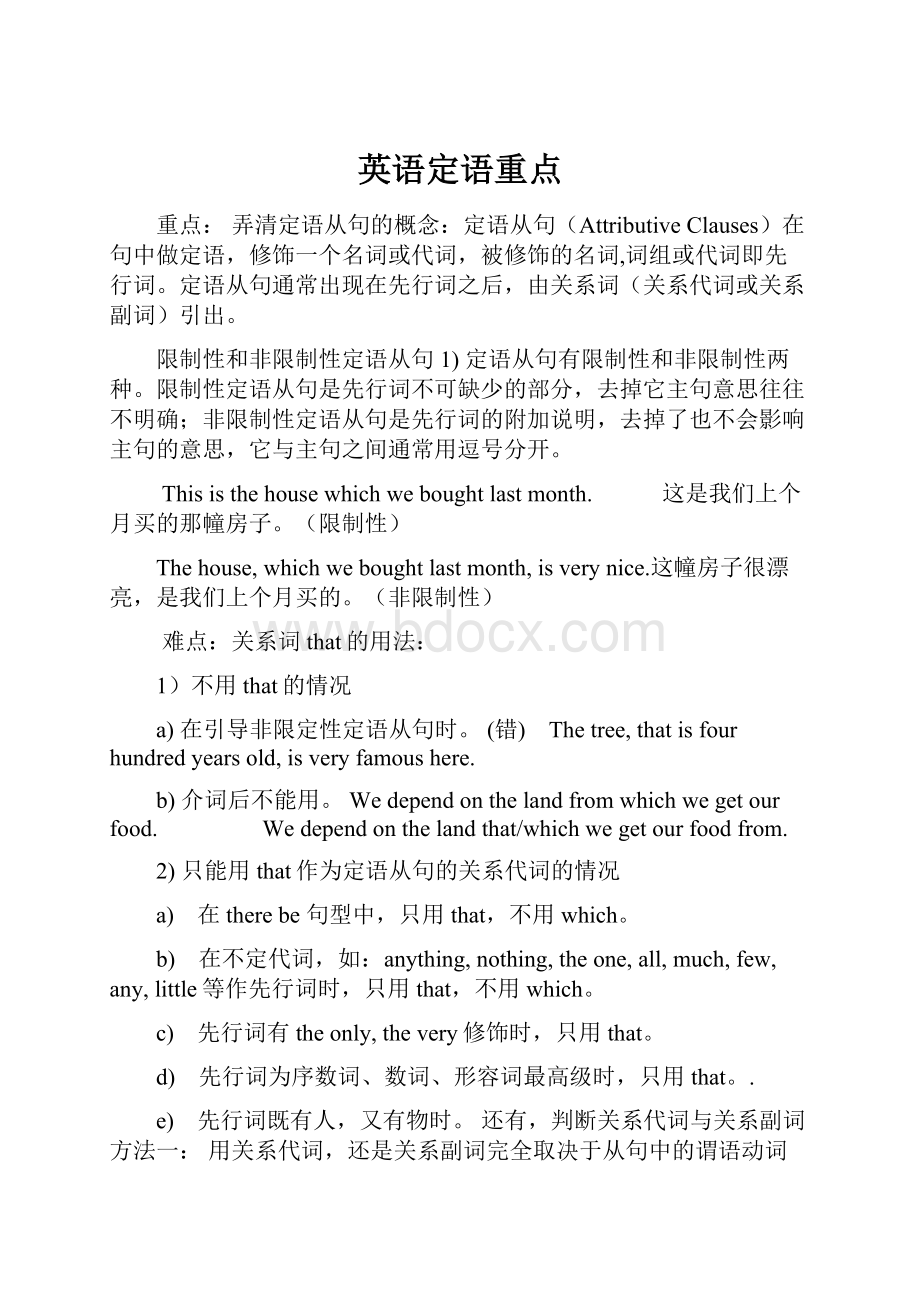英语定语重点.docx
《英语定语重点.docx》由会员分享,可在线阅读,更多相关《英语定语重点.docx(10页珍藏版)》请在冰豆网上搜索。

英语定语重点
重点:
弄清定语从句的概念:
定语从句(AttributiveClauses)在句中做定语,修饰一个名词或代词,被修饰的名词,词组或代词即先行词。
定语从句通常出现在先行词之后,由关系词(关系代词或关系副词)引出。
限制性和非限制性定语从句1)定语从句有限制性和非限制性两种。
限制性定语从句是先行词不可缺少的部分,去掉它主句意思往往不明确;非限制性定语从句是先行词的附加说明,去掉了也不会影响主句的意思,它与主句之间通常用逗号分开。
Thisisthehousewhichweboughtlastmonth. 这是我们上个月买的那幢房子。
(限制性)
Thehouse,whichweboughtlastmonth,isverynice.这幢房子很漂亮,是我们上个月买的。
(非限制性)
难点:
关系词that的用法:
1)不用that的情况
a)在引导非限定性定语从句时。
(错) Thetree,thatisfourhundredyearsold,isveryfamoushere.
b)介词后不能用。
Wedependonthelandfromwhichwegetourfood. Wedependonthelandthat/whichwegetourfoodfrom.
2)只能用that作为定语从句的关系代词的情况
a) 在therebe句型中,只用that,不用which。
b) 在不定代词,如:
anything,nothing,theone,all,much,few,any,little等作先行词时,只用that,不用which。
c) 先行词有theonly,thevery修饰时,只用that。
d) 先行词为序数词、数词、形容词最高级时,只用that。
.
e) 先行词既有人,又有物时。
还有,判断关系代词与关系副词 方法一:
用关系代词,还是关系副词完全取决于从句中的谓语动词。
及物动词后面无宾语,就必须要求用关系代词;而不及物动词则要求用关系副词。
方法二:
准确判断先行词在定语从句中的成分(主、谓、宾、定、状),也能正确选择出关系代词/关系副词。
还有,介词+关系词这种句型很重要!
一、限定性定语从句1.that即可代表事物也可代表人,which代表事物;它们在从句中作主语或宾语,that在从句中作宾语时常可省略关系词,which在从句中作宾语则不能省略。
而且,如果which在从句中作“不及物动词+介词”的介词的宾语,注意介词不要丢掉,而且介词总是放在关系代词which的前边,但有的则放在它原来的位置2.which作宾语时,根据先行词与定语从句之间的语义关系,先行词与which之间的介词不能丢3.代表物时多用which,但在带有下列词的句子中用that而不用which,这些词包括all,anything,much等,这时的that常被省略4.who和whom引导的从句用来修饰人,分别作从句中的主语和宾语,whom作宾语时,要注意它可以作动词的宾语也可以作介词的宾语5.where是关系副词,用来表示地点的定语从句6.when引导定语从句表示时间〔注〕值得一提的是,表示时间“time"一词的定语从句只用when引导,有时不用任何关系代词,当然也不用that引导BythetimeyouarriveinLondon,wewillhavestayedtherefortwoweeks.IstillrememberthefirsttimeImether.Eachtimehegoestobesinesstrip,hebringsalotoflivingnecessities,suchastowers,soap,toothbrushetc.7.whose是关系代词,修饰名词作定语,相当于所修饰成分的前置所有格8.当从句的逻辑主语是some,any,no,somebody,anybody,nobody,something,anything,everything或nothing时,常用thereis来引导二、非限定性定语从句:
非限定性定语从句的作用是对所修饰的成分作进一步说明,通常和主句间用逗号隔开,将从句拿掉后其他部分仍可成立1.which引导的非限定性定语从句来说明前面整个句子的情况或主句的某一部分2.在引导限定性定语从句时,that有时相当于inwhich,atwhich,forwhich或atwhichAttitudestowardsdaydreamingarechanginginmuchthesamewaythat(inwhich)attitudestowardsnightdreaminghavechanged.人们对白日做梦的态度正在改变,这与人们对夜间做梦的看法的变化有非常相似之处。
Ilikethemusicfortheveryreasonthat(forwhich)hedislikeit.我出于某种原因喜欢这种音乐,而他恰恰与我相反。
Wearrivedthedaythat(onwhich)theyleft.刚好我们到的那天他们走了。
3.有时as也可用作关系代词4.在非限定性定语从句中,不能用that,而用who,whom代表人,用which代表事物三、定语从句结构错误1.缺关系词2.从句中缺成分摘自《简明英语语法》在英文中,有两种定语从句:
限定性定语从句与非限定性定语从句。
这两种定语从句在其功能和形式方面都有明显的区别:
限定性定语从句限定性定语从句与主句的关系很紧奏,对其先行词起限定、修饰的作用。
如果将其去掉,会影响句子意思的完整性;有时甚至于引起费解、误解。
例如:
Rainforestsarebeingclearedforvaluabletimberandotherresourcestospeeduptheeconomicgrowthofthenationsinwhichtheyarelocated.为了加速他们各自所在国家的经济发展,热带雨林作为有价值的原木和其他资源正为人们所砍伐。
Oceancurrentsaffecttheclimatesofthelandsnearwhichtheyflow.洋流影响其流经的附近地区的气候。
Theyexplainedthereasontouswhytheyhadhatedusbefore.他们向我们解释为什么他们不喜欢我们的原因。
非限定性定语从句非限定性定语从句在形式上就与主句很松散,它与主句之间有一个逗点","隔开;它对其先行词没有限定、修饰的作用,只起补充、说明的作用。
有时也用它来对全句进行补充、说明。
即使将其去掉,也不会影响句子意思。
由于上述原因,非限定性定语从句在表达意思方面也有别于限定性定语从句。
另外,非限定性定语从句在中文译文里,我们往往将其作为一个分句处理,而不把它作定语翻译。
例如:
Earlier,theBabylonianshadattemptedtomaptheworld,buttheypresenteditintheformofaflatteneddiscratherthanasphere,whichwastheformadoptedbyPtolemy.(此句中,非限定性定语从句是对先行词asphere进行补充、说明。
)更早之前,巴比伦人曾试图绘制世界地图,但是他们把它绘制成平盘状而不是托勒密所采用的球体状。
Thecombinationofsatellites,whichtransmitinformation,computers,whichstoreinformation,andtelevision,whichdisplaysinformation,willchangeeveryhomeintoaneducationandentertainmentcenter.(此句中,三个非限定性定语从句分别对三个先行词:
satellites,computers和television进行补充、说明。
如果去掉这三个非限定性定语从句,那么句子可简化为:
Thecombinationofsatellites,computersandtelevisionwillchangeeveryhomeintoaneducationandentertainmentcenter.)卫星能传输信息,计算机能储存信息,电视能显示信息,把这些手段结合起来可以使每个家庭都成为教育娱乐的中心。
Thesunheatstheearth,whichmakesitpossibleforplantstogrow.(此句中,非限定性定语从句是对全句进行补充、说明,将全句表达的意思看成"一件事情)。
太阳给予大地热,这就使植物的生长成为可能。
Theoldmanhasason,whoisinthearmy.(此句中,非限定性定语从句是对先行词son进行补充、说明。
但本句所传达的信息是:
"这位老人只有一个儿子"。
如果将此句改写成限定性定语从句:
Theoldmanhasasonwhoisinthearmy.那位老人有一个在部队工作的儿子。
那么,限定性定语从句就要对先行词son进行限定、修饰。
这样一来,句子所传达的信息就变成了:
"这位老人有一个儿子在部队工作,还有其他的儿子在干别的工作"。
)那位老人有一个儿子,他在部队工作。
一.几个基本概念
1.定语从句的定义:
用作定语的从句叫定语从句。
2.先行词:
被定语从句所修饰的名词或代词。
3.定语从句的位置:
紧跟先行词(名词或代词)之后。
4.引导词:
引导定语从句的词(包括关系代词和关系副词)。
﹙1﹚关系代词:
that/who/whom/which/as
﹙2﹚关系副词:
when/where/why
5.引导词的位置:
位于定语从句之前(先行词之后)。
【as除外】
6.引导词的功能(作用):
﹙1﹚连接先行词和定语从句。
﹙2﹚在定语从句中充当一定的成分(关系代词充当主语或宾语,关系副词充当状语)。
7.定语从句的类型:
﹙1﹚限定性定语从句(主句和定语从句之间无逗号)。
① 直接由引导词引导定语从句
The man who you’re talking to is my friend.
② 由介词+关系代词(whom/which)引导
The man to whom you’re talking is my friend.
I need a pen with which I can write a letter.
=I need a piece of paper on which I can write a letter.
介词的选用可根据从句中的相关词组确定,该介词通常可以放在关系代词之前,也可放在从句之尾。
例如:
The man (who/whom/that) I talked about at the meeting is from Beijing University.
=The man about whom I talked at the meeting is from Beijing University.
The palace (which/that) I often pay a visit to was built in the 17th century.
=The palace to which I often pay a visit was built in the 17th century.
﹙2﹚非限定性定语从句(主句和定语从句之间用逗号隔开)。
① 直接由引导词引导定语从句。
② 由介词+关系代词(whom/which)引导。
I live in a house far away from the city, in front of which is a big tree.
There is an apple tree standing at the gate, on which are many apples.
This is the man to whom I gave the book.
③ 由“代词/名词+of+whom/which”或“of which/ whom +名词/代词”(先行词指
人用whom,指物用which)引导。
One, some, any, none, all, both, several, many, most, neither, either等词、数词、分数或百分比与of whom或of which连用。
He has five children, two of whom are abroad.
(比较:
He has five children, and two of them are abroad.)
We have three books, none of which is/are interesting.
(比较:
We have three books, but none of them is/are interesting.)
除why和that不能引导非限定性定语从句外,其余引导词都可以,用法同限定性定语从句一样。
但要注意以下区别。
1.在形式上非限定性定语从句与主句有逗号隔开。
2.非限定性定语从句的作用:
它只是补充说明先行词的情况,翻译时可译成两个句子。
The engineer, whose leg was badly hurt, was quickly sent to hospital.
(那位工程师被很快送往医院,其腿部受了重伤)
The engineer whose leg was badly hurt was quickly sent to hospital.
(那位腿部受了重伤的工程师被很快送往医院)
3.在非限定性定语从句中,任何引导词都不能省略(包括引导词在此定语从句中充当宾语在内)。
指人做主语时只能用who, 做宾语时用whom;
指物做主语,宾语都用which; 关系副词用when或where,也不能省略。
The man, ______ is sitting on the chair, is my father.
The woman, _______ I met yesterday, is my English teacher.
The city, _______ is far away, is very beautiful.
He went to America, ______ his parents live.
He joined the Army yesterday, ______ I left, too.
4.whose引导非限定性定语从句:
The house, whose window faces south, is mine.
=The house, the window of which faces south, is mine.
=The house, of which the window faces south, is mine.
二.定语从句中关系代词和关系副词的基本用法。
1.who/that指人是主格在定语从句中代替先行词,又作定语从句的主语,不能省略。
Do you know the gentleman who/that is sitting there?
2.whom/who/that指人是宾格,在定语从句中代替先行词,又作定语从句的宾语(动宾或介宾)。
① 当作动宾(动词后接宾语)时,关系代词可省略。
Do you know the gentleman (whom/who/that) we met just now?
② 当作介宾(介词后接宾语)时:
介词不提前时,关系代词可省略;
介词提前时,关系代词不可省,即介词+whom(指人时介词后的关系代词只能用whom)。
The man (whom/who/that) I spoke with is my teacher.
The man with whom I spoke is my teacher.
※注:
固定的动词短语(动词+介词)如look for, take care of等不能把动词与介词拆开,既介词不能提至引导词前。
She is the right girl (who/whom/that) we are looking for.
3.whose:
指人或物,是所有格“…的”形式。
Whose+n.一起在定语从句中充当主语、宾语(动宾或介宾)即先行词的什么东西怎样了,whose不能省略。
。
Whose+n. = the +n. + of which/whom= of which/ whom+ the =n.
I didn’t find the desk whose leg was broken. (主语)
He is the student whose pencil I broke yesterday. (动宾)
The boss in whose company I work is very kind. (介宾)
4.which/that 指物,指代先行词且在定语从句中作主语或宾语(动宾或介宾)。
① 当作动宾时,关系代词可省略。
② 当作介宾时:
介词不提前时,关系代词可省略;
介词提前时,关系代词不可省,即介词+which(指物时介词后的关系代词只能用which)。
The house which/that was destroyed in the earthquake is weak.
The pen (which/that) you found yesterday is mine.
The games (that/which) the young men competed in were difficult.
The games in which the young men competed were difficult.
※注:
介词+关系代词即介词+whom/which(先行词指人用whom,指物用which)。
※5.as指人或物,在定语从句中可作主语,宾语,表语或状语,不能省略。
主要用于 “the same …as…;such …as…;so …as…;as … as…;as follows”固定结构中,形式固定此时的引导限定性定语从句。
要用as代替who(m), which, 或that引导定语从句:
Such people as knew Hill thought he was honest.
Such people as Hill knew thought he was honest.
My hometown is no longer the same as it was.
Here is so big a stone as no one can lift.
The child knows as much as grow-ups (know).
I’d like to have the same books as are used in your school.
He is not such a person as I expected.
He will marry as pretty a girl as he can find.
※注:
which和as可引导非限定性定语从句:
可以指代主句中的一部分或整个句子的内容,which和as都可以指代主句中的一部分或整个句子的内容,有时可以互换。
因此,当as/which指代前面的整个句子,或前句中的部分内容作定语从句的主语时,谓语用单数.
Our team lost the game, as/which was reported in the newspaper.
She was terrified, as/which I could see from her eyes.
He married her, as/which was natural.
区别:
①as引导的非限制性定语从句可以放在主句前面、插在主句中间或放在主句末尾;而which引导的非限制性定语从句只能放在主句后面。
He married her, as/which was natural.
=As was natural, he married her.
Mark Twin is a great writer, which/as is known to all.
=As is known to all, Mark Twin is a great writer.
②as引导的从句有“正如”、“正像”之意,而which则无此意。
常用句型有:
as we all know, as is known to all, as everybody can see, as is expected, As is known/ said/ reported/ told/ we all know等。
如:
As we all know, paper was first made in China.
To shut your eyes to facts, as many of you do, is foolish.
③主句和从句有因果关系时,用which.
Our class has won the football match, which made us very happy.
Bamboos are hollow, which makes them very light.
④从句含否定意义时常用which.
She didn’t pass the exam, which we couldn’t expect.
She didn’t pass the exam, as we expected.
6.when关系副词:
指时间。
在定语从句中作时间状语,不能省略。
此时的when还可用介词+which替换(此时先行词一定是表时间的名词)。
I still remember the time when I joined the League.
=I still remember the time on which I joined the League.
=I still remember the time (which/that) I joined the League on.
7.where关系副词:
指地点。
在定语从句中作地点状语,不能省略。
此时的when还可用介词+which替换(此时先行词一定是表地点的名词)。
I still remember the school where I joined the League.
=I still remember the school in which I joine